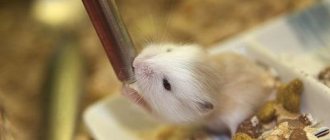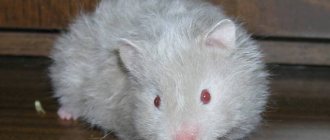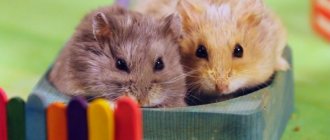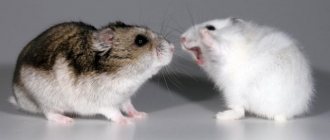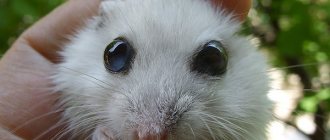When purchasing a rodent as a pet, many people wonder whether hamsters drink water. After all, it depends on whether you need to buy a drinking bowl. Opinions on the Internet on this matter differ - some believe that these animals receive enough fluid from succulent food (fruits, vegetables, berries). Others argue that water is essential for a hamster.
In nature
Both the Syrian hamster and the Djungarian come from arid regions - steppes and semi-deserts. The animals avoid open bodies of water, and during rare rains they take refuge in burrows. Usually a person does not understand what desert-dwelling hamsters drink. The source of moisture for tiny animals is dew that falls at night. They lick the drops from the blades of grass to their heart's content.
Filler
The cage must have a filler, which can be used as sawdust or shavings. They have the ability to absorb odor and water.
You can also use cellulose filler.
The corn filler retains odor and moisture well and is hypoallergenic. However, the hamster cannot dig in it and walking on solid particles can be uncomfortable.
It is strictly forbidden to use cotton wool, colored napkins, rags and newspapers, as well as sawdust or shavings from coniferous trees as bedding, as they can cause allergies in the hamster.
Causes of increased thirst
Heat
In a hot and stuffy room or in the sun, water is the only thermoregulation mechanism available to the rodent. Hamsters drink water to avoid overheating (heatstroke) and dehydration.
Pregnancy and lactation
During pregnancy, the female predictably begins to drink much more than usual. This is normal; under no circumstances should you limit your fluid intake.
Diseases
- Diarrhea
Regardless of the cause of diarrhea (poisoning, infection, poor diet), with indigestion the hamster loses a lot of fluid. Drinking helps restore the water-salt balance and is preferable to succulent food, which can aggravate problems with the gastrointestinal tract.
- Constipation
The opposite of diarrhea is the problem: dry food alone can cause stool retention, which is very dangerous for rodents. If a hamster has the opportunity to “wash down” food, this will prevent coprostasis.
- Diabetes
Excessive drinking and urination are the main signs of diabetes, to which Campbell's hamsters are so susceptible.
- Kidney problems
If your hamster drinks a lot and pees a lot, but the blood glucose level is not higher than normal, you can suspect diseases of the urinary system.
- Pyometra
If a hamster, when kept alone, begins to drink a lot, thirst indicates inflammation of the uterus (pyometra). The body thus tries to get rid of purulent intoxication.
How to accustom to a drinking bowl
Owners rarely encounter problems with drinking water, relying on their natural intelligence. The training procedure is much easier if the hamster knows the hands of its owner. It will be enough to show him the location of the drinking bowl several times, but if you only intend to get one, it is recommended to buy all the accessories in advance so that once in a new home, a curious hamster can explore every corner. Having stumbled upon the tip of the automatic drinker, he will definitely want to try it “by heart” and understand where he can get the vital liquid.
Small individuals sometimes simply do not know how to drink from an interesting device, and then the owner will have to help them master the home:
- The container is installed low so that you can freely reach the spout;
- leave your pet alone for a while, giving him the opportunity to master the drinking bowl on his own;
- If after several hours the hamster is still not interested in the device, then you need to pick it up and bring it to the tip. By touching it with his nose, he will feel the moisture and will be able to understand what the device is for.
It may take several attempts to fully learn the process, but do not force the hamster to drink - he must take the initiative himself and master his home.
If aggressive behavior occurs, you can use a trick - lubricate the tip of the drinking bowl with your favorite treat. Having smelled the smell, he will immediately run to the drinking bowl, and then taste it.
You cannot smear your drinking straw with products from the prohibited list, which include jam, honey or processed cheese.
Choosing a drinker
Arriving at the store, the buyer may encounter some difficulties when choosing a drinker. There are 2 types:
- ball, the functioning of which occurs after licking the ball at the tip of the tube. It rotates, the liquid goes into the mouth, but sometimes they often break. The ball stops spinning, as a result the hamster cannot drink;
- The reed type is designed differently; at the end of the tube there are 2 balls and a small vertical valve, when pressed, water will flow out.
The container itself should be transparent so that you can monitor the level, and the spout should be metal so that it does not get chewed off.
Water for a hamster
If the owner has no doubt about the need to give his pet something to drink, he wonders what kind of water to give his hamster. Ideally filtered or bottled. It is necessary to change it in the drinking bowl daily.
What kind of water to give hamsters – raw or boiled – depends on what you mean by “raw” water.
Water from a natural reservoir must be boiled for disinfection. Otherwise, the rodent may contract worms or an infection.
Another controversial issue is whether hamsters can be given tap water. Many owners do just this, but often it contains too much bleach, which shortens the pet's life. Chlorine and its derivatives are destroyed by boiling.
The harm of boiled water is the accumulation of salts in the body with constant use, and hamsters also suffer from urolithiasis.
Boiled water is called “dead”, it loses in taste, the hamster may refuse to drink for this reason.
People know what Djungarian hamsters drink in nature – dew drops. The closest thing to such a drink is not raw tap water, but good bottled water with low mineralization.
If your pet is sick, especially when refusing food, you need to know what to give your hamster to drink so that he gets better faster. For digestive disorders, this is rice water and a weak chamomile infusion. For colds - echinacea. Ascorbic acid and liquid vitamins for rodents are often added to the drinking bowl.
When thinking about what hamsters can drink: the liquid should be water based. Weak decoctions of herbs and grains are acceptable. Milk leads to severe digestive upset, alcohol tinctures are toxic. Soda and sweet drinks are deadly. It is better not to experiment and give regular fresh water.
Dairy
They contain calcium, which rodents need to strengthen teeth and bones. Products containing no more than 1% fat are allowed:
- cottage cheese;
- homemade yogurt;
- kefir.
Meat and boiled egg
Animal protein is necessary for the animal to grow and develop properly. It is recommended to give the following types of meat approximately once every 5-6 days:
- boiled chicken breast;
- rabbit meat;
- turkey meat;
- lean beef.
Bird eggs are also important for the rodent’s body; they are easily digestible and saturate the body with useful substances.:
- fat-soluble vitamins A, E, D;
- micro- and microelements (iron, calcium, sodium, potassium, cobalt, selenium, etc.);
- enzymes.
REFERENCE Pregnant, lactating females and babies are given protein food 2-3 times a week in small portions.
It is allowed to treat the short-legged fluffy with peeled boiled shrimp, white fish and gammarus (5-6 pieces) no more than once every 1-2 weeks.
Do you give your pet animal protein?
Is it possible to have bread?
Wheat and rye bread are contraindicated, because in the manufacture of these products chemically treated flour with the addition of raising agents, yeast, and salt is used. Rye bread has high acidity and causes fermentation and increased gas formation in hamsters .
What nuts can you
Nuts are a source of polyunsaturated fatty acids, vegetable protein and tocopherol, which have a beneficial effect on the condition of the coat and accelerate the healing of wounds. But due to the high calorie content, the hamster is given no more than once a week:
- half a hazelnut or cashew;
- 2-3 small pieces of walnut.
The nuts are pre-shelled.
REFERENCE In addition to nuts, the following is added to the animal’s diet:
- raw sunflower seeds;
- pumpkins;
- sesame and flax.
Dried fruits
The requirements for them are the same as for fresh fruits.
Dried apples and pears are allowed, rarely apricots dried naturally, without treatment with a preservative.
External features
This is a very active animal with a beautiful fur coat, the maximum size of which does not exceed 10 cm, and its weight is 45 grams. Features of the Djungarian's appearance include a dark stripe on its back, which distinguishes it from most of its fellows.
The fur of this species of hamster is variegated with white patches. This helps the rodent in natural conditions to perfectly camouflage and hide from predators. The following colors are especially common among domestic Djungarian hamsters:
- mandarin;
- pearl;
- sapphire;
- standard.
In winter, the animal's coat sheds and becomes almost white. The inclusions become almost invisible, and the gray stripe on the back still stands out. It's funny that even at home, when animals do not lack food, they store food, collecting it behind their chubby cheeks.
Spreading
Djungarian hamsters have a fairly wide habitat. The species is found in natural conditions in southern Transbaikalia, Tuva, in the Aginskaya, Chuya and Minusinsk steppes, in Altai, and in the steppes of Western Siberia. In addition, representatives of the species are found in Northeast China and Mongolia.
Djungarians build their burrow houses in steppe or desert landscapes, much less often on the outskirts of the forest-steppe. These babies are not afraid of saline, sandy, gravelly soils. In Altai they are found at an altitude of up to 3 thousand meters above sea level.
Instructions
The new pet must be allowed to get comfortable in the house and be allowed to explore the living conditions. When he calms down, he will begin to carefully study the cell. He may not need help in mastering drinking; after a while he will discover that he drinks without prompting. If this does not happen, you can accustom your hamster to the toilet, to the feeder and drinking bowl as follows:
- Let the animal into the house, do not touch or disturb it, after a while it will be able to find water and bury its face in it.
- If the rodent does not approach the device and does not drink, you can lightly poke its muzzle into the liquid and give it a drink.
- If the animal is wild and not yet accustomed to being handled, the nipple drinking device is lubricated with something aromatic. He can't resist the smell and starts licking it. If he does not do this, you need to slip the tip of the device under his nose and teach him how to use it.
Hamster rehydration
If your hamster is a little dehydrated after being out of the cage for several hours, you just need to add more water to the water bottle so that he can drink as much as he needs.
It is strictly not recommended to bathe your hamster in an attempt to alleviate its condition. This will be seriously stressful for him and can lead to hypothermia. In their natural environment, these animals do not swim because they live in the desert.
If there is reason to think that the hamster is severely dehydrated or it is impossible to say exactly how long ago he drank water, it is better to show the animal to a veterinarian. Severe dehydration can be fatal for your pet. The doctor will give him a saline solution with salts and minerals to restore balance.
To summarize, you need to give your hamster water to drink. In most cases, the moisture contained in a hamster's food is not enough for the normal functioning of his body. To maintain health and prolong the life of your pet, you should give him the opportunity to drink water whenever he wants.
Source
